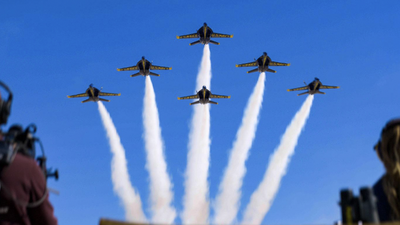There are lots of low-angled “heroic” shots of the pilots and moving shots taken from over their shoulders with a Steadicam as they stride through long corridors, and slow-motion shots of them walking towards and away from planes, taking off sunglasses and putting them on, and moments where they move abreast in a “power walk” formation familiar from many a Hollywood action flick. The movie is an ad for The Blue Angels, the Navy, planes, the military generally, and an iconography-based sense of patriotism, as much as the “Top Gun” films, the first of which was memorably described by New Yorker critic Pauline Kael as “a recruiting poster that isn’t concerned with recruiting but with being a poster.” (The precision flying showcased in the “Top Gun” movies is inspired by The Blue Angels, and it just so happens that one of this film’s producers is Glen Powell, costar of “Top Gun: Maverick.”)
And the flying itself? And the filming of it? It’s technically impressive. Not surprisingly framed, much less poetic (probably almost no one wanted that), but impressive. I saw The Blue Angels a couple of times as a kid and remember thinking that it seemed physically impossible for such large metal objects to fly so close to one another while roaring through the sky at hundreds of miles an hour. But they did it. They do it here, again, for the IMAX cameras, which seemingly were affixed to multiple parts of the planes’ exteriors and cockpits. (How is it possible that we never see those cameras in the shots? Were they digitally erased later? Or are the cameras just that small, and the camera crew just that smart?)
Director Paul Crowder, who also helped edit the movie, tries to find a narrative through-line by sketching out the members of the Blue Angels team. He focuses mainly (though not exclusively) on the Commanding Officer and Flight Leader, aka “Boss,” Captain Brian Kesselring, who eventually left the Angels and is now Deputy Commander, Carrier Air Wing (CVW) 5. “My feeling is, you should never feel too comfortable in the suit,” he says.
Other members of the squadron drift in and out of the foreground. There’s a bit of material about the strain placed on marriages and families by the pilots being on the road 300 days a year, but no talk of affairs, divorces, or anything like that (the Navy wouldn’t have permitted it anyway). Towards the end of the movie, through a fluke of production timing, we also get to meet the Blue Angels’ first-ever female pilot, Amanda Lee, and watch her be inducted.

